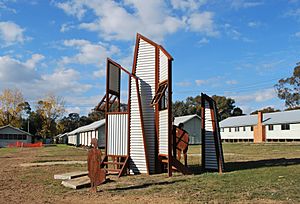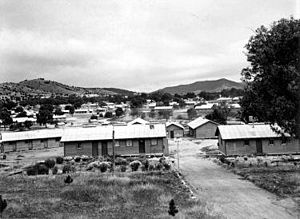Bonegilla Migrant Reception and Training Centre facts for kids
The Bonegilla Migrant Reception and Training Centre was a special camp. It was set up to welcome and train people moving to Australia after World War II. This was a time when many people came to Australia.
The camp was on a large piece of land, about 130 hectares (320 acres), near a town called Wodonga in Victoria. It was close to the Hume Dam. Before it became a camp, it was an Australian Army base during World War II.
Bonegilla camp opened in 1947 and closed in 1971. During these years, over 300,000 migrants arrived there. It's thought that more than 1.5 million Australians today are related to someone who stayed at Bonegilla. Famous people like actor Eric Bana's parents and scientist Karl Kruszelnicki were processed there.
Contents
Bonegilla Migrant Camp: A New Home in Australia
Why People Came to Australia After WWII
For 24 years, Bonegilla was Australia's biggest and longest-running migrant reception center. About 309,000 people arrived there. After World War II, in 1945, the Australian Government wanted more people to live in the country.
This led to many new centers opening, including Bonegilla. Laws like the Aliens Act of 1947 and the Migration Act of 1958 helped more people come to Australia.
At first, the government hoped many British people would move to Australia. But not many came. So, they looked to Europe, where millions of people had been forced to leave their homes because of the war. These people were called "displaced persons."
Many of these migrants were offered a trip to Australia. In return, they agreed to work for two years. They stayed at places like Bonegilla to learn about the "Australian way of life."
Life at Bonegilla: What Was It Like?
The camp had very basic facilities. It was quite separate from the nearby towns of Albury and Wodonga. Most people who came to Bonegilla did not speak English.
The camp had 24 different sections, called blocks. Each block had its own kitchen, dining hall, and bathrooms. There were over 800 buildings in total. The rooms were made from timber frames with corrugated iron walls. They were built for 20 people and had no walls inside, so there was little privacy.
When migrants first arrived in 1947, the camp wasn't fully ready. By 1950, Bonegilla could hold 7,700 people. Later, internal walls and small cubicles were added to give people more privacy. These improvements happened faster when Dutch and British migrants started arriving.
When new migrants arrived, they usually came by ship to Melbourne. Then, they took a train to Bonegilla. Officials would meet them with food and a place to stay.
People were often grouped by their home country. Men and women were kept in separate areas, even if they were married. People used their luggage or blankets to create small private spaces.
For fun, people could take dance classes, visit a library, play soccer, or swim in Lake Hume. There was also a cinema that showed movies twice a week.
Officers helped migrants find jobs across Australia. Migrants could sometimes choose their jobs. However, if they kept refusing job offers, they might lose their benefits. Many men were called 'labourers' and women 'domestics.' Many migrants were upset because their skills and qualifications from their home countries were not recognized. They often had to start with simple jobs.
Who Lived at Bonegilla?
Most of the migrants at Bonegilla came from Europe. Many of them were from countries where English was not spoken. From 1947 to 1951, almost all migrants were from southern and eastern Europe.
Later, in 1951, new agreements were made with the Netherlands and Italy. This meant that more people from these countries, as well as Britain, started coming to Bonegilla. This changed the mix of people living at the camp.
Bonegilla's Story Lives On: Legacy and Commemoration
In 1990, Block 19 of the camp was protected. This stopped 28 of its huts from being torn down. Other buildings had already been demolished after the camp closed in 1971. Block 19 was saved because it is a very important symbol of how migration after the war changed Australia.
Today, Block 19 is the only part of the camp left. It is now a museum and a place where visitors can learn about its history. In 1997, the Albury Regional Museum started collecting items for a festival. This festival celebrated 50 years since Bonegilla opened.
Different groups of people who had lived at Bonegilla also held reunions in 1987, 1997, and 1999. They shared food, music, and dance. In 2001, the Victorian Government gave money to build a special center at Block 19 for visitors.
The Bonegilla Migrant Experience Heritage Park reopened to the public in 2010. It is a National Heritage Place. Visitors can take tours of the remaining buildings and learn about the site's history. They can also look up family records and arrange school trips. Many groups, including former Bonegilla residents, helped to reopen the park.
See also
- Benalla Migrant Camp - another camp nearby that received migrants from Bonegilla
- Rushworth - another camp nearby that received migrants from Bonegilla





